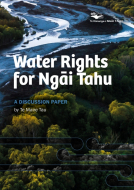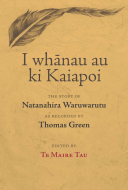
- Agriculture
- Architecture & Design
- Arts & Photography
- Biography
- Business
- Calendars and Diaries
- Childrens (All)
- Childrens (Illustrated)
- Childrens (Picture flats)
- Childrens (Te Reo)
- Classics
- Cooking, Food & Drink
- Craft & Hobbies
- Design (Art / Graphics)
- Design (Interiors)
- Education
- Fashion
- Fiction & Literature
- Fiction - Young Adult
- Gift Ideas
- Health & Wellbeing
- History
- Home & Garden
- Humour & Gift
- Instead of a Card Poems
- Military
- Music
- New Zealand
- NZ (History)
- NZ (Landscapes)
- NZ (Pictorial)
- Poetry
- Reference
- Religion & Faith
- Science & Nature
- Sport & Recreation
- Stationery
- Taschen : 40th Anniversary Edition
- Taschen : BA Basic Art
- Taschen : BU Bibliotheca Universalis
- Te Reo Māori
- Transport
- Travel
Te Maire Tau (2)
|
Water Rights for Ngai Tahu A discussion paper
ISBN: 9781988503035 Author: Te Maire Tau Publisher: Canterbury University Press There is perhaps no issue in New Zealand today more contentious than water rights. The Crown claims that no one owns water, but its use, irrigation and treatmen... There is perhaps no issue in New Zealand today more contentious than water rights. The Crown claims that no one owns water, but its use, irrigation and treatment are controlled by local governments empowered by the Crown. Since the 1990s resource consents for the taking of water, in Canterbury and Southland especially, have increased dramatically and the environmental situation is reaching a breaking point. After years of discussion some kind of system regarding the ownership of water is inevitable. In Water Rights for Ngāi Tahu, Te Maire Tau considers the historical and political framework that has contributed to the current state of water rights in the Ngāi Tahu takiwā. He explores the customary, legal and Treaty frameworks that feed into the debate regarding the ownership of water. From 1844 to 1864 the Crown purchased more than 34.5 million acres of land from Ngāi Tahu, but in most purchase deeds water is not mentioned. How does this play into claims to water? Should the Treaty be relied upon? How far can kaitiakitanga take us if the goal is mana motuhake and tino rangatiratanga? In this short book Te Maire Tau lays out the historical background and context to water rights, and opens a discussion about where to proceed next in determining a Ngāi Tahu position on water. Bind: paperback Pages: 74 Dimensions: 148 x 210 mm Publication Date: 17-11-2017 |
$25.00 |
|
|
I whanau au ki Kaiapoi
ISBN: 9781877578120 Author: Te Maire Tau Publisher: Otago University Press Natanahira Waruwarutu was a child at the time of the capture of Kaiapoi Pa by Te Rauparaha's Ngati Toa warriors in 1832. The early years of his life, recounted ... Natanahira Waruwarutu was a child at the time of the capture of Kaiapoi Pa by Te Rauparaha's Ngati Toa warriors in 1832. The early years of his life, recounted here in the original Maori text and an accompanying translation, saw great change in the Maori communities of Waitaha (Canterbury) and Akaroa. Otako leaders set aside Moeraki, further south, for Kaiapoi refugees and Waruwarutu moved between the two places until he died in 1895. Before his death, he passed on to scribe Thomas Green, himself a Ngai Tahu elder, a substantial body of material that now defines modern understanding of the traditional history of Ngai Tahu. This manuscript was part of that material and, as Te Maire Tau describes in his introduction, has a history of its own. The story in this book is not a Ngai Tahu 'Grand narrative'. As Te Maire Tau says, Maori history simply does not work like that. Rather, it is one narrative by a survivor of the period 'that recollects the reality of what he saw as a child; on this basis, it is a superb example of an oral tradition.' The author has included a chapter on the historical context of Waruwarutu manuscript and annotations for both Maori and English texts. A further chapter presents in Maori with English translations a text recorded by scribe Charles Creed that supplements Waruwarutu's account of his induction into the Kaiapoi whare purakau (house of learning). It is one of the few manuscripts that provides a glimpse into a world that no longer exists. Bind: paperback Pages: 112 Dimensions: 155 x 230 mm |
$30.00 |




